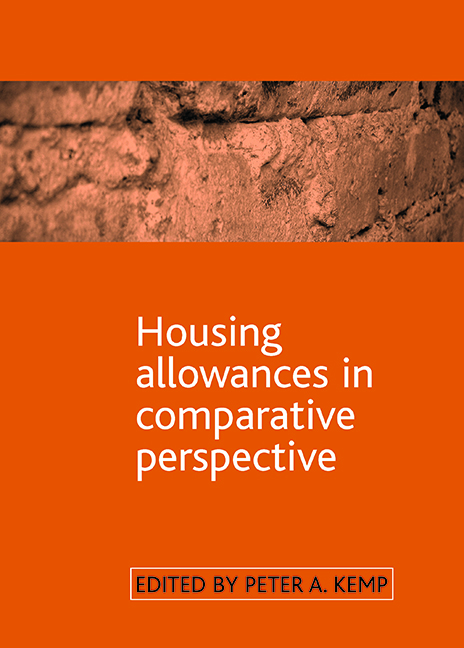Book contents
- Frontmatter
- Contents
- List of tables and figures
- Acknowledgements
- Notes on contributors
- one Housing allowances in context
- two Housing allowances and the restructuring of the Australian welfare state
- three The New Zealand experience of housing allowances
- four Canadian housing allowances
- five Housing allowances American style: the Housing Choice Voucher programme
- six Housing Benefit in Britain: a troubled history and uncertain future
- seven Housing allowances in France
- eight Housing allowances in Germany
- nine Housing allowances in the Netherlands: the struggle for budgetary controllability
- ten Housing allowance systems in Sweden
- eleven Housing allowances in the Czech Republic in comparative perspective
- twelve Housing allowances in the advanced welfare states
- Index
five - Housing allowances American style: the Housing Choice Voucher programme
Published online by Cambridge University Press: 15 September 2022
- Frontmatter
- Contents
- List of tables and figures
- Acknowledgements
- Notes on contributors
- one Housing allowances in context
- two Housing allowances and the restructuring of the Australian welfare state
- three The New Zealand experience of housing allowances
- four Canadian housing allowances
- five Housing allowances American style: the Housing Choice Voucher programme
- six Housing Benefit in Britain: a troubled history and uncertain future
- seven Housing allowances in France
- eight Housing allowances in Germany
- nine Housing allowances in the Netherlands: the struggle for budgetary controllability
- ten Housing allowance systems in Sweden
- eleven Housing allowances in the Czech Republic in comparative perspective
- twelve Housing allowances in the advanced welfare states
- Index
Summary
Introduction
In the US, housing allowances take the form of housing vouchers. Whereas housing allowances are typically unrestricted cash transfers earmarked for housing, housing vouchers are earmarked for housing but have restrictions. Put simply, a voucher is essentially a promissory note from the government – with strings attached. It allows a low-income household to lease a physically decent private market unit that is rented for an amount considered reasonable for modest, existing, standard rental units in the housing market area, typically the county or metropolitan area.
Unlike housing allowances in most other countries included in this volume, housing vouchers in the US, along with all other forms of housing assistance, are not entitlements. As a result, roughly one quarter of eligible households receive any form of housing assistance (Fischer and Sard, 2005; US Department of Housing and Urban Development, 2005), and about 9% receive vouchers (US Department of Housing and Urban Development, 2005; Fischer, 2006). Nonetheless, the housing voucher programme now serves more households – roughly 2 million – than any other means-tested form of housing assistance (Fischer, 2006).
Housing policy context
Although housing assistance programmes in the US date back at least 75 years, a housing allowance-like programme was introduced only about three decades ago. Prior to the 1970s, housing policy for low-income households consisted of an array of construction and finance subsidies. These included federal subsidies to build and rehabilitate housing, reduce interest rates on loans to developers of housing for low- and moderate-income households, provide mortgage insurance for lowincome homeowners and rental apartment developments, and provide tax shelters to investors in low- and moderate-income housing projects (Weicher, 1980). By the early 1970s, virtually all of these housing programmes had run into serious problems. These included abandonment of federally subsidised homes, defaults in apartment subsidy programmes, scandals involving bribery of public officials in a low-income homeownership programme (Section 235), and significant social decay in some public housing developments, the most infamous of which was Pruitt-Igoe in St Louis. President Richard Nixon called for a moratorium on all housing programmes and established a taskforce to recommend a course of action for the future.
- Type
- Chapter
- Information
- Housing Allowances in Comparative Perspective , pp. 87 - 104Publisher: Bristol University PressPrint publication year: 2007
- 1
- Cited by

